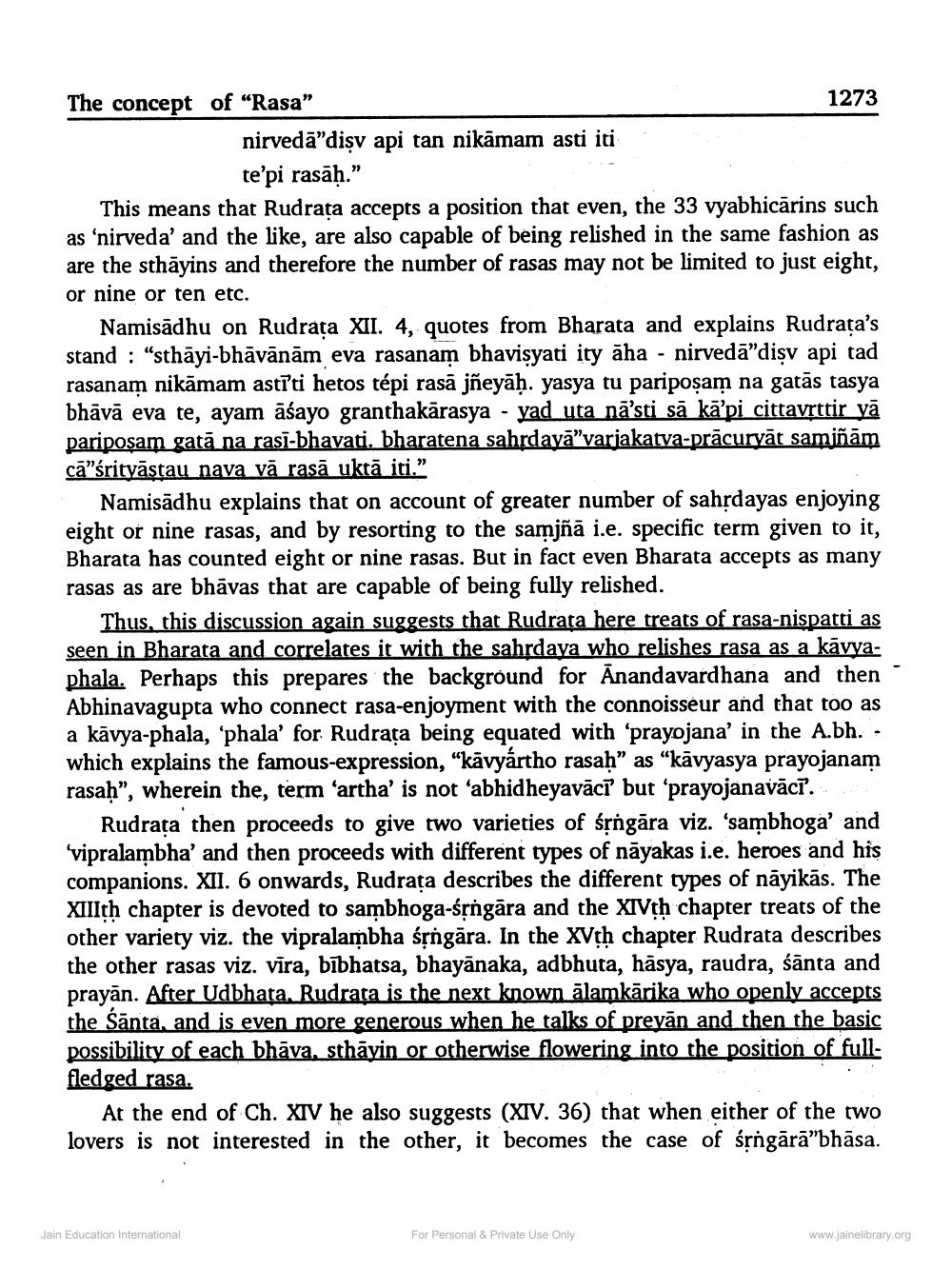________________
The concept of “Rasa”
1273 nirvedā”dişv api tan nikāmam asti iti
te'pi rasah." This means that Rudrata accepts a position that even, the 33 vyabhicārins such as ‘nirveda' and the like, are also capable of being relished in the same fashion as are the sthāyins and therefore the number of rasas may not be limited to just eight, or nine or ten etc.
Namisādhu on Rudrata XII. 4, quotes from Bharata and explains Rudrata's stand : "sthāyi-bhāvānām eva rasanam bhavisyati ity āha - nirvedā"disv api tad rasanam nikāmam astīti hetos tépi rasā jñeyāḥ. yasya tu pariposam na gatās tasya bhāvā eva te, ayam āśayo granthakārasya - yad uta nā'sti sā kā’pi cittavrttir yā pariposam gatā na rasī-bhavati. bharatena sahrdavā"varjakatva-prācuryāt samiñām ca”śrityāstau nava vā rasā uktā iti."
Namisādhu explains that on account of greater number of sahrdayas enjoying eight or nine rasas, and by resorting to the samjñā i.e. specific term given to it, Bharata has counted eight or nine rasas. But in fact even Bharata accepts as many rasas as are bhāvas that are capable of being fully relished.
Thus, this discussion again suggests that Rudrata here treats of rasa-nispatti as seen in Bharata and correlates it with the sahrdava who relishes rasa as a kávya. phala. Perhaps this prepares the background for Anandavardhana and then Abhinavagupta who connect rasa-enjoyment with the connoisseur and that too as a kavya-phala, 'phala' for Rudrata being equated with 'prayojana' in the A.bh. which explains the famous-expression, "kávyártho rasah" as "kāvyasya prayojanam rasaḥ”, wherein the, term 'artha' is not ‘abhidheyavāci but 'prayojanavācī.
Rudrața then proceeds to give two varieties of śộngāra viz. 'sambhoga' and 'vipralambha' and then proceeds with different types of nāyakas i.e. heroes and his companions. XII. 6 onwards, Rudrața describes the different types of nāyikās. The XIIIth chapter is devoted to sambhoga-śộngāra and the XIVth chapter treats of the other variety viz. the vipralambha śộngāra. In the XVth chapter Rudrata describes the other rasas viz. vīra, bībhatsa, bhayānaka, adbhuta, häsya, raudra, śānta and prayān. After Udbhata. Rudrata is the next known alamkārika who openly accepts the Santa, and is even more generous when he talks of preyān and then the basic possibility of each bhāva, sthāvin or otherwise flowering into the position of fullfledged rasa.
At the end of Ch. XIV he also suggests (XIV. 36) that when either of the two lovers is not interested in the other, it becomes the case of śộngārā”bhāsa.
Jain Education International
For Personal & Private Use Only
www.jainelibrary.org




